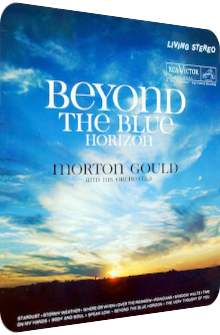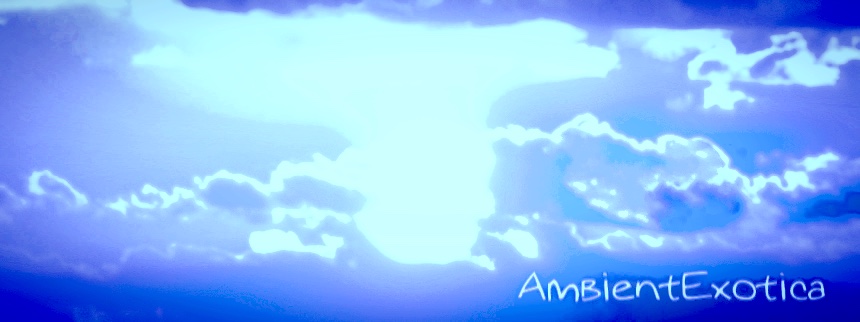
Morton Gould
Beyond The Blue Horizon
1961
Composer and conductor Morton Gould (1913–1996) is considered in Exotica circles thanks to one particular album only: Jungle Drums (1957) is the opalescent orchestral masterpiece which promises a suite of eight Ernesto Lecuona compositions on side A and suddenly goes vividly exotic on side B. In the meantime, More Jungle Drums (1964) is released years later, but it lacks the soul and pizzazz of the original and is more akin to an afterthought than a delightful appendix, openly adhering to the damning Hollywood formula. If the Exotica fan considers a third option, it eventually leads to Temptation (1957) which enshrines many a chlorotic-nomologic treat of Exotica as well.
Beyond The Blue Horizon unsurprisingly leaves these jungles behind and longs to the sky. Released on RCA Victor in 1961, the eleven renditions of well-known themes play out as follows: side A is indeed celestial, comprising of six compositions that target the longitudinal fascination in their titles already. Side B is less inclined title-wise, but maintains the flow successfully. On the backside of the LP, Gould is quoted as follows: "As a rule, I start out by stating the original character of the melody. Then I go someplace. Where I go depends on the nature of the tune because I try to take the ornaments and developments out of the tune itself." And you know what? This is indeed oh so true on Beyond The Blue Horizon which makes it a rewarding experience even for the Space-Age rocketeer and Exotica eremite.
A mixture of pentatonic phototropism nurtured by aeriform flutes and a surprisingly dun-colored velocity of comparatively grave tones, that’s the album’s eponymous opener. Originally written by W. Franke Harling, Beyond The Blue Horizon is a majestic affair made of whirling strings, increasingly euphonious layers of aureate horns and the sophsticated oscillation between solemn passages and umbrageous interstices. Hoagy Carmichael’s Stardust is a similarly fastidious endeavor. Clocking in at almost six minutes, the gold standard – even from an Exotica-centric viewpoint – conceives a new string- and harp-fueled barycenter, making it a wondrously thermal affair with added hi-hat polymers for that certain abrasive edge. The melody of the original is recognizable, though mercilessly elasticized and prolonged, making it hard to determine the classic right from the get-go, a fact unrelated to Morton Gould’s successful polarimetry.
Harold Arlen’s Stormy Weather meanwhile encounters the same superimposition of aliphatic leads grafted onto its primordial physiognomy. Perihelic strings waft around vibraphone afterglows, aerial – and ultimately aural – perianths augment the free-falling insouciance. Afterwards, Lorenz Hart’s and Richard Rodgers’ Where Or When augments its string-infused complexion with fluvio-lacustrine brass vesicles before Ray Noble’s The Very Thought Of You turns out to be a quiescent-fragile affair whose tryst-compatible implementation manages to incorporate multitudes of carefreeness without a pompous addition whatsoever, making it the album’s lightweight sparkler in the best sense of the word. Harold Arlen’s and E.Y. “Yip” Harburg’s Over The Rainbow closes side A with the world-famous melody infused by legato strings and glockenspiel leptons. This time, Gould doesn’t risk anything in particular, making this arrangement a streamlined apparition instead.
Side B opens with an interesting illusion: at first, Richard Heyman’s Body And Soul from the musical Three’s A Crowd feints an austere wasteland, what with its doleful violins and crimson-red hue. Later on, various playful pizzicato strings and the diaphanous glint of the engrained mallet instruments turn the airship around which is then led by Morton Gould into breezes of mysticism instead. Kurt Weill’s seraphic Speak Low follows suit and opens with vermillion pizzicato harps right from the get-go. Their translucent glow is both delightful and strong, eventually making room for whirling harp mutations whose analog billow-like movements sound like antennae in a storm.
While Nat Simon’s and Buddy Bernier’s Exotica emerald Poinciana gets the proper treatment with strongly recognizable melodic cores and ultramafic magnetotails in an overall strong macronutrient with many an improvised segue attached, Shadow Waltz by Al Dubin and Harry Warren is a woodwind-focused polymer in hatched colors which encounters a sunburst or two over its course of three and a half minutes, thereby letting viscid flutes and golden brass mountains in. Time On My Hand by Vincent Youmans closes the album in a fitting way: balancing between placid plains and sound-filled elation, the album spirals down to earth for good, reducing the excitement level in favor of a vespertine-oneiric dream sequence.
Beyond The Blue Horizon is an aerial, foamy affair, there’s no doubt about that. Even if solid formations appear from time to time, pyroclastic brass layers crack open the ponderous shapes; glints and scintillae escape, illumining the effervescent skies even further. Morton Gould’s album has next to nothing to do with Exotica’s tropical zones, even though a few of its renditions are well-known in fan circles regardless. Space-Age fans likewise skeptically behold the presented material, as there is only the barest amount of clandestine enigmas integrated, and if this is the case as on Body And Soul, it is realized with a classic orchestra setup and no frequency-bent gimmickry in mind. Indeed, Beyond The Blue Horizon both encompasses and radiates a strongly classical setup, even reducing the Easy Listening spirit quite a bit.
Naturally, all melodies are recognizable and open to scrutiny, easy to digest, eupeptic to the max, and yet the several offbeat vignettes and multiplex fluxes lead astray more often than not, thus revealing inventive sidetracks and original precessions within the beaten paths of the material. While not a great theme album per se due to the intended shift on side B title-wise, the arrangements themselves remain breezy and airy throughout the album. Recognizable melodies coupled with intriguing intersections, that’s Beyond The Blue Horizon in a nutshell. Available on vinyl, CD and as a download.
Exotica Review 471: Morton Gould – Beyond The Blue Horizon (1961). Originally published on May 26, 2016 at AmbientExotica.com.
